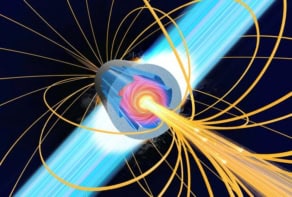
Physicists in the US have developed a new technique to improve the stabilization of a laser’s frequency inside an optical cavity. Known as “magnetically induced optical transparency” (MIT), the technique employs a magnetic field to reduce the linewidth of the stabilized frequency below that of the cavity and to render it largely immune from cavity vibrations. The work might lead to more robust portable laser systems, such as transportable atomic clocks, say the researchers.
The frequency of a laser is usually stabilized by bouncing the beam multiple times between two mirrors in an optical cavity. The distance between the mirrors is set equal to an integer number of half wavelengths of the laser light to achieve resonance. The problem is that the length of the cavity can vary over time, due, for example, to temperature fluctuations or seismic vibrations, so reducing the frequency stability. Even in very advanced cavities, fluctuations occur due to the Brownian motion of atoms in the mirror coatings.
Rather than relying on a constant cavity length, MIT uses the inherently stable frequency of a particular atomic transition. Developed by James Thompson and colleagues at the National Institute of Standards and Technology and the University of Colorado in Boulder, the scheme uses a static magnetic field to induce the Zeeman effect in a group of very cold atoms. The field splits the excited state of an atomic transition whose energy equals the frequency of the laser, such that the two sub-states are in energy terms equally distant from the original state – one being very slightly above it and the other very slightly below.
Impaired absorption
When the atoms are placed in a cavity without a magnetic field, the laser light that is fired into the cavity is absorbed by the atoms (since the frequency of the light and transition match), with the relaxing atoms then scattering light in all directions. But when the field is applied, absorption is impaired. Although the laser can still excite some atoms into the two sub-states, the slight mismatch between laser and transition frequencies limits the excitation and allows the beam to bounce back and forth between the mirrors. The idea is that by tuning the laser frequency up and down, a peak in the cavity output will occur at the frequency of the atomic transition.
Thompson’s team demonstrated MIT by loading around one million strontium-88 atoms into a cavity monitored by a photon counter. The researchers found, as expected, that when they applied a magnetic field across the cavity and then tuned the laser to the appropriate strontium transition, the power transmitted to the photon counter peaked.
They increased the field strength to widen the energy gap between the two sub-states, and therefore open the “window” of permitted frequencies. The result was an increase in output power but also a broadening of the laser’s linewidth. Conversely, by decreasing the field and narrowing the window they were able to make the line much sharper. At very low fields they could approach the inherent width of the atomic transition line, generating a line that was some 20 times narrower than would be possible using a standard atom-free cavity.
Linewidth versus power
The scheme offers a trade-off between linewidth and power – reducing the width as far as possible without boosting absorption to the extent that scattering overheats the chilled atoms. But as the researchers point out, the window could be closed further – allowing more stable frequency measurements – by using a different kind of atom with a longer-lived excited state, since inherent linewidth is inversely proportional to the lifetime. Although the strontium transition is already quite long-lived, both calcium and magnesium have more durable excitations, they say.
MIT is a variant of electromagnetically induced transparency, a technique first demonstrated more than 20 years ago in which a “pump” laser opens up a frequency window in a medium for a “probe” laser to enter. A virtue of this scheme, explains Thompson’s colleague Matthew Norcia, is that the window can be almost closed even if the inherent linewidth of the transition is not that narrow. The problem, he says, is that any noise in the pump is transferred to the window, and hence to the probe. Since the probe can’t be made more stable than the pump, the approach cannot provide an absolute fix of a laser’s frequency.
That is not true of MIT, which exploits an unvarying – and hence un-noisy – magnetic field. Norcia says the best optical cavities today are already very precise and, because they are highly engineered, probably couldn’t incorporate clouds of atoms. Therefore the new technique is unlikely to improve on state-of-the-art frequency stabilization. But it could be useful for improving the stabilization of mobile laser systems, where vibrations can play havoc with the stability of optical cavities.
Simpler optical clocks
One such system, suggests Norcia, is the portable optical clock, which can be used to compare atomic timekeeping around the world and bring us closer to an optical- rather than microwave-based definition of the second. Optical clocks use cavities to stabilize timekeeping between periodic comparisons of their laser frequencies and the frequency of a suitable atomic transition. By putting atoms inside the cavities, he says, the clocks could be made simpler and more robust.
MIT is described in Physical Review Letters.


